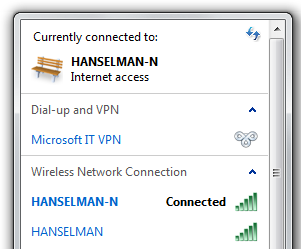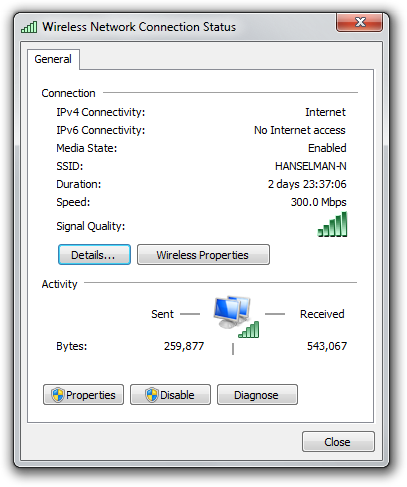A few months ago I added a second wireless access point (AP) to my existing network in order to get better wireless coverage. We have a house that's kind of spread out and we were getting really spotty 802.11g around the house. Laptops we getting one or two bars, or worse yet, they were constantly negotiating network speeds and never getting a decent one. The iOS devices (iPhone, iPad, etc) would barely get any signal in certain rooms. It was certainly irritating.
So, I added a second identical AP with the same SSID upstairs so we could move between floors without trouble. However, this AP (some crappy standard one that came with the FIOS service) was/is really inconsistent. While the network architecture is solid, as is the idea behind my "add a second AP" post, the implementation using these 5 year old crappy routers was flaky at best.
Techie Background: I have FIOS optical internet service, and have for the last 3 years. It's upgraded from 15Mbs to 35Mbs recently. The house is Gigabit Ethernet (all CAT6, see the related links below). All the wired devices are running through a Netgear GS724T-300 24-port Gigabit Smart Switch and all of the wireless devices are at least 2.4Ghz 802.11g, and some are 802.11n, with one being 2.4Ghz or 5Ghz.
Since I have a home office, meaning I literally work at home 90% of the time for my living, having flaky wireless is a problem. I decided to start researching a better solution. I decided to add a new wireless router. I figured that it was insane for one house to have to APs and that surely if a cell phone could work over miles that a freaking wireless network router could cover a single house. I found the solution in the Netgear N600 Gigabit.
Here's the idea:
However, there are some important notes when adding a new wireless router to an existing system that is already performing these functions
- Passing out IP addresses via HDCP
- Acting as a wireless access point with lots of existing clients
- Has existing static IP leases setup, existing quality of service (QoS) settings
Stated differently, my existing router is nicely and intricately configured for my house. It works fine and I like it fine, except it has crappy wireless. I want to add a new wireless router without disturbing what already works. If it ain't broke, don't fix it.
I picked up a Netgear N600 Wireless Gigabit Router. Note that there are two versions of this, one with a large bright LED on the outside and one without. The one without has 4 Gigabit LAN ports, and that's the better router.
Let me tell you that this router is awesome. I figured I'd be moving from a 3-5 year old crappy router to some better router, sure, but not a totally awesome Swiss Army Knife. Networking has come a long way since 2005 or whenever my stock router was made.
This Netgear is awesome because of these features:
- Two separate bands for wireless, each with 300Mbs of independent bandwidth. There's 2.4GHz and 5.0GHz frequencies. Nice for copying VMs over wireless. I made a "HANSELMAN" and "HANSELMAN-N" network.
- Four Gigabit Ethernet points. Not needed for me, but it's nice to have four more Gigabit ports.
- Eight internal antennas - Seriously, this thing has insane range. I had already added an external antenna to my FIOS router and still had bad range. This little Netgear covers 3500+ square feet and more. I'm thrilled with the range. I don't need two routers anymore. Adding this router totally achieved my goal.
There were a few gotchas. I still need my ISP's router because it's the bridge to the ISP and the Optical Network Terminal (ONT) they installed on the house. It's also totally configured as I like.
Here's the steps I took:
- Logged into the FIOS ActionTec at http://192.168.1.1 and disabled the wireless interface. I confirmed that the "HANSELMAN" network was no longer showing up.
- Plugged the Netgear directly into my laptop and visited it's default IP of http://10.0.0.1. I disabled the new router's DHCP (this is crucial).
- Important Trick: I temporarily plugged the new Netgear's yellow "external network" directly into the FIOs ActionTec so the Netgear could update its firmware the first time and get the initial setup wizard would stop nagging me. The router expects to be hooked up in this way at least initially, so you need to satisfy its setup.
- After the Netgear is configured, now unplug the yellow external LAN wire and instead plug into one of the standard four ethernet ports into either your switch (that's what I did, gigabit to gigabit) or directly into your ISP's router. We want the new router to get an IP address from our existing router and route traffic and DHCP requests to the ISP's router. To be clear: Setting up your new router in this way will leave the yellow upstream external network port empty, despite what the documentation says.
- On the new router, setup the 2.4GHz wireless network with your SSID, and the 5GHz wireless network with something like YOURSSID-N. Here's what I did:

Now I've got 192.x.x.x addresses being handed out on two wireless networks. My Wireless-N network is getting 300Mbs throughput on my Lenovo, as its Intel Wireless LAN does 5Ghz 802.11n. Also, my iOS devices are using 2.4Ghz 802.11n and are suddenly a LOT snappier on large downloads and email.

I'm absolutely thrilled with the a Netgear N600 Wireless Gigabit Router. It's the top of the line for the house, definitely a "prosumer" router and a really nice upgrade to any existing system if you know a little about setting up your network. Totally recommended.
Related Links
- Configuring two wireless routers with one SSID (network name) at home for free roaming
- Wiring the house for a Home Network
- Wiring the house for a Home Network - Part 2 - Design Q&A
- Wiring the house for a Home Network - Part 3 - ISP Hookup
- Wiring the house for a Home Network - Part 4 - Thank You Cat 6 Gigabit Ethernet
- Wiring the house for a Home Network - Part 5 - Gigabit Throughput and Vista
- New Job, New House, New Baby, and Designing a Totally New Home Office
- How To: Use Google Earth or Virtual Earth to Visualize a New House Lot - Part 1
- How To: Use Google Earth and SketchItUp to Visualize a New House Lot - Part 2
© 2010 Scott Hanselman. All rights reserved.

Tidak ada komentar:
Posting Komentar